A chemical eye burn is an emergency that requires immediate medical attention. It is important to properly cleanse the mucous membrane of the irritant in order to achieve complete healing in the future. You need to know how to properly provide first aid for an eye burn with chemicals, so as not to worsen the damage.
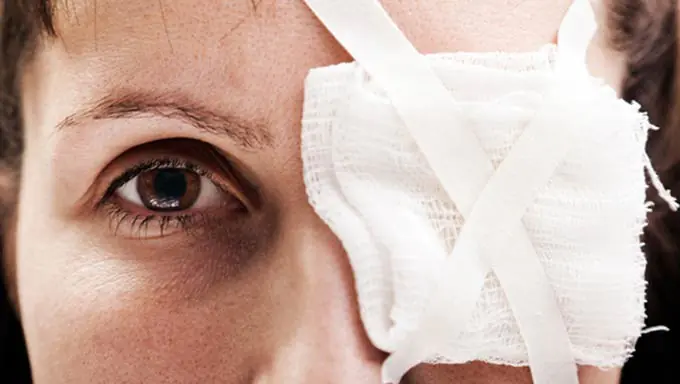
How can you burn your eyes?
Most often, chemical burns to the eyes occur at work. You can injure the mucous membrane at home if you do not follow safety precautions when using household chemicals, lime, and ammonia. Even if a small amount of the substance is used, gloves and special safety glasses must be worn. Regular glasses do not adhere to the skin and leave pathways for irritants to enter.
Eye burns can occur during eyelash extensions. The glue used in the salon is a strong irritant. Contact with it causes swelling, itching, burning, redness and pain.
Chemical burns to the eye are a common consequence of using a gas spray for self-defense. Upon contact with an irritant, blepharospasm may occur, that is, the eye will close abruptly and will not open. Usually the spasm lasts for an hour if the eye is not washed out in time. It is recommended to blink for 5 minutes after rinsing to restore muscle function.
Degree of eye burn
Almost all chemicals can irritate the mucous membranes of the eye, but serious damage occurs upon contact with strong alkalis and acids. Alkali burns occur most often, but they are also the most dangerous, especially with bilateral damage. Often such injuries result in visual impairment.
The severity of a chemical burn will depend on the volume, temperature and concentration of the irritant, duration of exposure and degree of penetration. In some circumstances, the person's age is also important: in general, children tend to have more severe burns.
There are four degrees of eye burns, but the mechanism of damage by alkalis and acids is different. The initial assessment of burn severity is based on the degree of corneal transparency and the severity of ischemia (blanching).
Degree of eye burn:
- First degree (favorable prognosis). It is characterized by the absence of ischemia and the transparent state of the cornea.
- Second degree (good prognosis). Ischemia affects a third of the limbus, there is clouding of the cornea, but details of the iris are visible.
- Third degree (ambiguous prognosis). There is clouding of the corneal stroma, the epithelium is completely lost, ischemia from a third to half of the limbus masks the details of the iris.
- Fourth degree (poor prognosis). Ischemia affects most of the limbus, and there is total opacification of the cornea.
Additionally, the filling of limbal vessels is considered. When determining the degree, the extent of destruction of the corneal epithelium, the presence of symptoms of conjunctivitis, the condition of the lens and iris, as well as indicators of intraocular pressure are also taken into account.
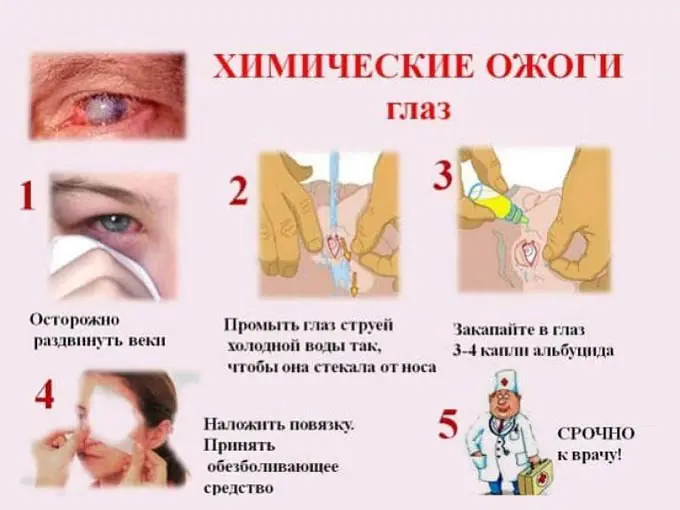
Features of burns with acids and alkalis
Eye burns from sulfuric acid are not as dangerous as from alkali. This is due to the fact that a film of coagulated protein forms on the eye when the irritant reacts with the mucous membrane. The film does not allow acid to penetrate deep into the eye, protecting the eye from deep damage. However, coagulation does not protect against complications if a concentrate of nitric and hydrofluoric acids gets into the eyes. An acid burn is characterized by severe pain, and sometimes even painful shock.
It is noteworthy that when the eye is damaged by alcohol, a person experiences severe pain, but minimal damage is noted. However, alcohol can absorb moisture from the lubricating fluid and the eyeball, penetrating deep into and damaging the cornea and lens. If washed in a timely manner, there will be no consequences for vision.
The most dangerous are alkali burns. In this case, there is severe dehydration and cell destruction. Alkalies provoke the decomposition of protein structures, wet necrosis develops, and when the irritant gets into the intraocular fluid, the deep structures of the eye are affected. Alkali can reach the corneal stroma and trabecular meshwork. As a result, the cornea becomes cloudy and intraocular pressure increases.
- Deterioration of vision. The initial decrease in visual acuity is caused by epithelial defects, increased lacrimation, clouding and discomfort. Even with moderate to severe burns, vision may be preserved if the corneal clouding is minor, but severe deterioration will occur over time.
- Fragments of the irritant in the arches of the outer shell. Residues of foreign matter are visible when plaster and other solid irritants enter the eye. The fragments must be removed immediately, otherwise they will continue to release toxins and worsen the damage. Only after cleansing the eye does the natural recovery process begin. Carbide and lime are the most dangerous because they dissolve in the tear and cause severe damage. If these substances come into contact, do not delay cleansing.
- Increased intraocular pressure. A sharp increase in pressure occurs due to deformation and contraction of collagen fibers in the anterior part of the eyeball. Subsequently, the increase is associated with inflammation.
- Inflammatory process in the conjunctiva. Even with mild damage, swelling and redness of the mucous membrane is noted. Sometimes when a burn occurs, the color of the conjunctiva changes (brown when damaged by chromic acid, yellowish when exposed to nitric acid).
- Perilimbal ischemia. Based on the degree of blanching, one can make a prediction about the restoration of the cornea, because limbal sprout cells restore the epithelium. Severe ischemia indicates an unfavorable course of the process.
- Cloudiness. If the cornea is transparent, a zero degree of damage is determined, and if the cornea is completely clouded, the fifth degree is determined. Complete stromal opacification makes it impossible to examine the anterior chamber of the eye.
- Defects of the corneal epithelium. Damage to the cornea can be expressed as diffuse punctate keratitis or complete absence of the epithelium. In the latter case, the defect is poorly stained with fluorescein and may not be diagnosed. If the epithelial defect is not visible during the initial examination, prompt re-examination is recommended.
- Corneal perforation. The symptom appears a few days after a severe eye burn, when the cornea's ability to regenerate decreases.
- Inflammation in the anterior region. The reaction may affect single cells or have a pronounced fibrinoid form. Inflammation is more pronounced when alkali gets into the eye, since these substances can penetrate deep into the structures.
- Scarring or other damage to the conjunctiva and eyelids. The symptom may be a problem if scarring prevents the palpebral fissure from closing.
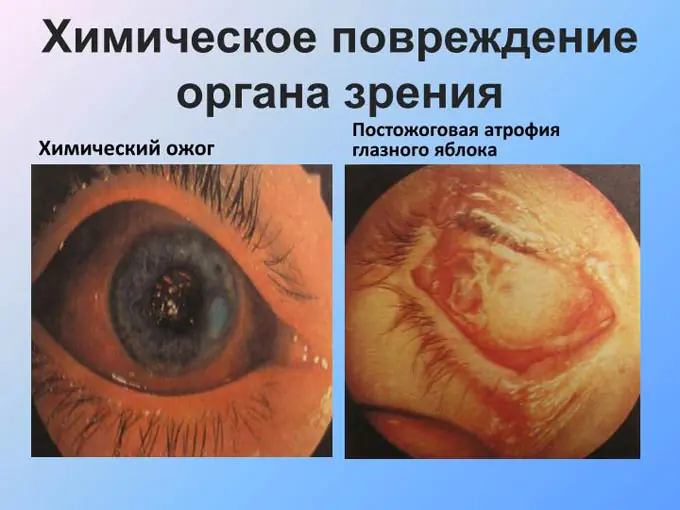
What to do if you have a chemical burn to the eye
Before providing first aid, you need to transfer the victim to a dark room to minimize the effect of light on the eyes and relieve pain. Folk remedies for chemical eye burns are ineffective, and some can be dangerous. Do not wash your eyes with tea or herbal infusion. It is not recommended to refuse the help of doctors in favor of traditional medicine.
First aid for a chemical burn to the eye:
- Remains of the substance are removed from the eyelids with a cotton swab.
- The eyes are rinsed generously under running water for 15 minutes. It is recommended to additionally wash alkaline burns with a 2% boric acid solution, and acid burns with a soda solution.
- If there is severe pain, the patient should be given an effective pain reliever.
- Instill a 4% solution of novocaine or lidocaine, or a 0.2% solution of chloramphenicol.
- Use a disinfectant (0.25% Levomycetin, Sebizone, Albucid-sodium, Acetopt, Ophthalmite, Gentamicin drops).
Rinsing should last more than 15 minutes. You can use clean water, sodium chloride solution (0.9%) or a weak solution of potassium permanganate. If it is not possible to use a special solution, tap water can be used. Potential infection in the long term is not as dangerous as long-term poisoning from the remnants of the irritant.
Treatment of chemical burns to the eye
The entire process of treating a chemical burn can include both conservative and surgical methods. The main thing is to preserve vision. Patients with severe burns need to be hospitalized immediately. In case of damage to degrees I and II, it is advisable to consult a doctor after providing first aid and follow all recommendations at home.
Stages of treatment for chemical eye damage:
- Removing the irritant. The most important step in emergency care for chemical burns is copious rinsing. If possible, the eye should be anesthetized before rinsing. Local anesthesia reduces pain and blepharospasm. It is advisable to use a sterile buffer solution (normal saline or Ringer's solution).
- Control of the inflammatory process. At the time of damage, inflammatory mediators are released, which provoke necrosis. This process inhibits re-epithelialization and increases the risk of ulcers and corneal perforation. You can interrupt the inflammation with the help of local steroids; citrate or ascorbic acid is additionally prescribed. To inhibit collagenosis and prevent ulcers, 10% or 20% Acetylcysteine is sometimes used.
- Acceleration of regeneration. Full epithelization begins only after the irritant is removed from the eye. Chemical damage causes a temporary increase in tear production and a decrease in future tear production, so it is important to use moisturizers for healing. Ascorbic acid helps restore collagen structure and accelerate corneal regeneration. In some cases, wearing therapeutic bandage lenses is recommended.
Since chemical burns to the eyes are accompanied by severe pain, the victim is prescribed powerful anesthetics. Additionally, anti-inflammatory drugs and drugs that prevent the formation of adhesions are used. Treatment of burns usually begins with tetanus vaccination.
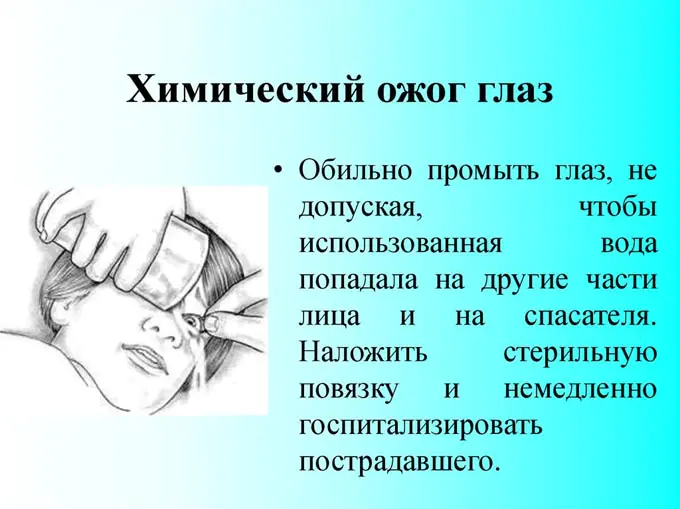
If severe inflammation develops during a burn, doctors prescribe glucocorticosteroids:
- Dicaine. Eye drops with leocaine and sodium chloride have a local anesthetic effect, relieve pain and prepare the cavity before surgery. The dosage is determined by the degree of burn.
- Ciprofloxacin. The ophthalmic drug is available in the form of drops or ointment, but in case of a burn, the use of a solution is recommended. Ciprofloxacin has antibacterial and anti-inflammatory effects. The drug is instilled every 15 minutes for the first 6 hours, then every half hour the next day. On days 3-14, the interval is increased to 4 hours. Ciprofloxacin is only allowed in patients over 1 year of age.
- Atropine. For chemical burns to the eyes, this remedy helps reduce pain and prevent adhesions. The active ingredient is atropine sulfate. The drug is instilled three times a day, 1-2 drops.
- Diacarb. The drug in tablet form is prescribed for increased intraocular pressure. The effectiveness of Diacarb is due to the content of acetazolamide, magnesium stearate, povidone, croscarmellose sodium and other substances. Usually prescribed one tablet 3-4 times a day. Diacarb is contraindicated in diabetes mellitus, acute liver and kidney failure, uremia, hyponatremia, metabolic acidosis, hypokalemia, in the first trimester of pregnancy and during lactation. The drug is prescribed to patients over 3 years of age.
- Prednisolone. This glucocorticosteroid is taken only with the permission of a doctor. Usually prescribed one tablet per day. Prednisolone is contraindicated for fungal infections.
Although chemical burns require emergency treatment, the prognosis is often good. If the damage did not affect the deep structures of the eye, and the appropriate measures were carried out in a timely and correct manner, the preservation of vision will be ensured. In some cases, even immediate help does not prevent the formation of an eyesore. Even after successful treatment, scars may remain and affect the quality of vision.
A serious chemical burn does not occur without prolonged and severe pain. At the initial stage, oral analgesics are most often used. The spam of the ciliary muscle can be weakened with the help of cycloplegic drugs.
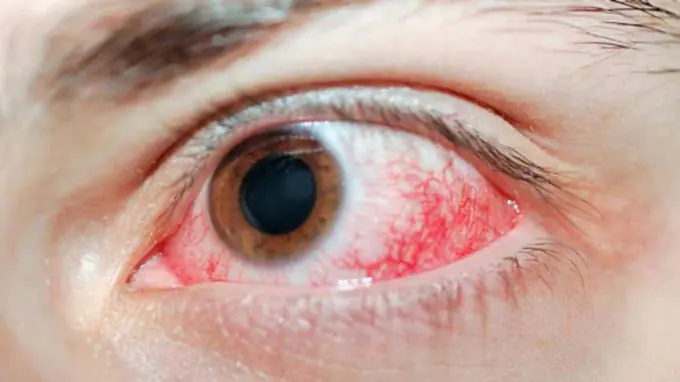
If the burn has severely damaged the corneal epithelium, the risk of infection increases. At the initial stage of therapy, antibiotics are prescribed for prophylaxis. Minor, deep corneal injuries can be treated with cyanoacrylate eye glue.
If elevated pressure levels are observed during a burn, blockers of the production of intraocular fluid are prescribed. Such drugs are indicated both at the initial stage of treatment and during late rehabilitation therapy. When elevated intraocular pressure persists even with the use of antihypertensive agents, surgical intervention (penetrating antiglaucoma or surgery with shunt or valve devices) is required.
Surgical treatment of eye burns and possible complications
If conservative methods are ineffective, surgical treatment of the consequences of the burn is performed. Depending on the complications, a variety of techniques are used.
Surgical treatment for an eye burn may include:
- partial removal of areas of necrosis of the conjunctiva or corneal surface;
- temporary covering with amniotic membrane;
- transplantation of limbal cells or cultured corneal epithelial cells;
- removal of the fusion of the conjunctiva of the eyelids with the eyeball (symblepharon).
To speed up rehabilitation, penetrating or partial keratoplasty and keratoprosthesis are used. If a cataract occurs, it is extracted.
Primary complications of a chemical burn include conjunctivitis, corneal erosion, swelling or clouding, acute increase in intraocular pressure, and melting of the cornea. Secondary complications are usually more varied.
Possible consequences of a chemical burn to the eye:
- glaucoma;
- cataract;
- scarring of the conjunctiva;
- corneal ulcers;
- thinning and tearing of the cornea;
- destruction of the corneal surface;
- opacification and vascularization;
- subatrophy of the eye.
The main measure to prevent burns is to follow safety precautions when working with household chemicals and in production where chemicals are used. It is important to exercise caution and wear safety glasses.
Due to exposure to acid or alkali, a person can receive a chemical burn to the mucous membrane of the eye. Depending on the severity of the chemical burn, the damage is accompanied by clouding of the cornea of the eye, redness of the conjunctiva of the eyelids, and even complete loss of vision.
If an eye injury occurs, first aid is necessary at the very beginning. This will help avoid complications caused by the use of chemicals. A burn to the retina with alkali is more severe than with an acid. Reactions such as tissue death, inflammatory reaction of the anterior cornea, and swelling of the conjunctiva are possible even with mild damage. In this article we will look at what to do in case of a chemical burn to the eyes, what medications are recommended to be used, and how to treat a chemical burn to the eye when providing first aid.
Main reasons

Most often, damage to the organs of vision from chemicals occurs in industrial conditions. Often when welding, calcium carbide is used, which also causes damage. Agriculture involves the use of toxic chemicals that cause damage. However, you can get injured in other situations:
- incorrect use of household chemicals. Young children are often injured if hazardous substances are freely available;
- construction work using chemical reagents (in most cases damage occurs due to lime, ammonia, etc.);
- improper handling of vehicle batteries. The device contains sulfuric acid;
- there is a burn of the cornea of the eyes with pepper spray;
- the damage occurs as a result of a cosmetic procedure for eyelash extensions, which uses glue containing dangerous compounds.
Failure to comply with safety precautions increases the risk of chemicals entering the membrane of the organs of vision, resulting in tissue necrosis. If handled incorrectly, damage may occur from potassium permanganate, known as potassium permanganate.
Burns are caused by acids and alkalis. In the first case, the protein begins to fold, which causes damage in a limited area. With timely assistance, serious consequences can be avoided.
When in contact with alkali, the reagents do not form a scab on the outer areas of the eyes and penetrate deep into the tissue. This can cause vision loss even if you seek medical attention promptly.
Symptoms and complications
Symptoms of an eye burn begin to appear in the first minutes after the surface comes into contact with dangerous compounds. These include:
- the appearance of pain syndrome;
- a burning sensation and a desire to scratch the damaged area;
- increased lacrimation;
- redness of the mucous membrane, as well as the area of skin around it;
- swelling on the face;
- acute reaction to light;
- there is a feeling that there is a foreign object on the shell.
With severe degrees of injury, the effects of burns may become more pronounced. A person cannot open his eyes, blisters with purulent contents appear, and the mucous membrane becomes cloudy. Scars may also appear on the cornea, cataracts or glaucoma may develop, and partial or complete loss of vision may occur.
If first aid is not provided in time for a chemical burn to the membranes of the eyes, irreversible complications may develop. Some occur in the first hours after injury, others - several days after it. The following complications are quite often noted:
- vision deteriorates;
- there is an increase in intraocular pressure;
- a defect in the corneal epithelium occurs, as well as thinning of its tissues;
- an inflammatory reaction occurs in the anterior part of the eye;
- ulcers form;
- There is a gradual death of the organ of vision.
Emergency help
In case of any chemical damage, the first step is to rinse the mucous membrane in order to reduce further exposure to harmful components. To do this, you need to use clean water, preferably from a bottle. You can also rinse with saline or Ringer's solution. There should be a lot of liquid to completely wash out the reagent.
The algorithm for providing medical care includes the following steps:
- washing the affected organ of vision;
- the use of reagents, the choice of which depends on the type of burn - acid or alkali;
- if damaged by cement or other mortars, remove the remaining substance from the shell with a sterile cotton swab;
- Disinfectant eye drops are used.
The main thing with PMP is washing the mucous membrane. It must be done immediately as soon as a harmful substance comes into contact with the cornea. The slightest delay can result in more serious damage. It takes long enough to rinse the mucous membrane to completely eliminate the chemical compound (about half an hour).
If an acid injury occurs, a soda solution is used to normalize the balance. Alkali damage is eliminated by exposure to a 2% boric acid solution. To get rid of large particles, you need to pull back the eyelid and carefully remove the substance. To do this, they usually use cotton swabs soaked in saline solution.
Additionally, you can instill painkillers containing novocaine or icecaine into the victim. A person should be in a darkened room so that the visual organs do not react so sharply to light.
For any degree of damage, it is necessary to call an ambulance and show the victim to a specialist. Before the arrival of doctors, it is allowed to disinfect the tissues using special eye disinfectant solutions. They will help eliminate the first symptoms and avoid complications if you receive a severe chemical burn to the eye. Treatment at home does not involve the use of folk remedies, since medicine recommends treating this type of injury according to the classical scheme.
Treatment
Medications and other methods of recovery should be prescribed by an ophthalmologist. The first remedies include rinsing and removing foreign substances that have entered the cornea. When damaged by chemical components, tissue death occurs, which complicates the healing process. To speed up regeneration, local use of antibiotics and other anti-inflammatory medications is prescribed.
As additional means, drugs are used that disinfect the affected area and also prevent the occurrence of ulcers. Natural tears are also used to prevent the membranes from drying out.
One of the methods of restorative therapy is the removal of dying tissue. This is usually done when the mucosal surface is treated. Such treatment should only be carried out in a medical facility to avoid possible complications.
The following groups of medications are used for treatment:
- painkillers;
- antibiotics;
- natural tear preparations;
- glucocorticosteroids;
- drops that reduce blood pressure, etc.
During the recovery period, attention is paid to how quickly tissue restoration occurs, as well as whether intraocular pressure increases. In serious cases, surgery is used. It may consist of the following actions:
- removal of dying tissue;
- cutting the fused conjunctiva of the eyelids;
- stem cell transplant;
- scar removal;
- correction of existing glaucoma or cataracts;
- replacement of the cornea with an artificial prosthesis.
If the organs of vision are damaged by chemical reagents, it is important to provide timely assistance to the victim. If you remove a dangerous substance in the first seconds, the risk of complications is reduced. The most severe cases of burns can lead to cataracts, glaucoma, and vision loss. However, with a quick visit to a medical facility, these and other pathologies can be excluded.
Eyes are the most vulnerable place of our body. They consist of a large number of parts, each of which performs an important function. It is enough to damage one of them for a person to partially or completely lose the ability to see. For minor injuries, the process is temporary, and visual acuity returns after adequate treatment. However, if the damage is severe, changes in the eye may be irreversible.
The most common injury to this organ is a burn received while operating a gas welding machine. The electric arc releases such a large amount of energy that it is divided into two parts. The first generates a thermal (thermal) wave that directly melts the metal. The second one creates strong ultraviolet radiation. Eye burns from welding can result from both of these effects.
Structure of the eye
To understand why you should not delay providing first aid for eye burns, and why they are dangerous, you need to know the approximate structure of the organ. Its structures are arranged sequentially. They can be roughly divided into those that refract light and those that perceive images. The latter includes only the retina.
Let's list the main parts, starting with the most superficial:
- The conjunctiva is a thin protein membrane covering the eye;
- The cornea is the first structure to refract light;
- The iris is an important part consisting of muscle, connective tissue and pigment cells that give a certain color to the eye. Regulates the process of pupil dilation/constriction;
- The lens is a biconvex lens-shaped structure of the eye that focuses light;
- The sclera is the largest layer of the eye and performs protective and refractive functions;
- The retina senses light and gives rise to the optic nerve.
If one of these structures is damaged, the eye cannot perform its function normally. A burn to the retina has the most severe consequences, since this part consists entirely of nerve endings and is responsible for the perception of light.
How can you burn your eyes when welding?
Depending on the cause of occurrence, there are two types of eye burns from welding:
- Thermal - it develops when very hot substances or liquids come into contact with one of the parts of the eye. The organ of vision can be damaged by flying scales, splashes of hot metals, scalding steam (when using hot-dip galvanizing technology, hot air welding, etc.);
- Ultraviolet burn (radiation) - this injury can be caused not only by a welder, but also by an ordinary passer-by who looks at the electric arc. Ultraviolet light typically only damages the surface of the eye, so it is considered less dangerous.
First aid and treatment differ significantly for various eye injuries, so it is important to promptly determine the type of burn. This can be done using simple signs that will be described below.
Chemical burn to the eyes
This type of damage is much more dangerous than exposure to scale or exposure to ultraviolet radiation. Eye burns from chemicals manifest themselves with the same symptoms as after welding. However, there is one important difference - in 85% of cases the damage is deep and irreversible.
In principle, chemical burns are divided into acid and alkaline.
Typical representatives of alkalis are soda, lime, ammonia solutions, and cleaning products. They are present in every person’s everyday life, and are extremely dangerous if they come into contact with the eyes. The fact is that alkalis enter into chemical reactions with the conjunctiva, cornea and sclera, rapidly destroying them. Therefore, a chemical burn to the mucous membrane of the eye quickly becomes deep and damages all structures, right up to the retina.
It is quite difficult to remove alkali from fabrics, so it is important that first aid is provided as early as possible.
Easier to deal with than alkali damage. When acid gets in, the superficial structures of the eye are often damaged. During the chemical reaction, a lot of protein is released from the destroyed mucosa, which delays the acid on its way to the retina. Therefore, with timely assistance, visual function can be preserved.
In everyday life, the following acids are most often used:
- Potassium permanganate (synonym: potassium permanganate) - there is an additional sign that will help determine damage to manganese. At the same time, the mucous membrane turns brownish-brown;
- Vinegar;
- Nitric acid – is included in almost all solutions for cleaning metals;
- Formaldehyde is a typical component of nail polish remover;
- Lemon acid;
- Boric acid.
Symptoms of an eye burn
Regardless of the cause of the burn (ultraviolet radiation, scale, acid, etc.), eye damage manifests itself with almost the same symptoms. These include:
- Severe lacrimation;
- Pain in the eyes;
- Decreased visual acuity;
- Increased sensitivity to light (or even photophobia);
- Redness of the eyes due to the appearance of a vascular pattern on the sclera;
- Feeling of “sand in the eyes” - the patient constantly wants to rub his eyes or wash them with cold water. This symptom is very pronounced when the cornea of the eye is burned by welding;
- Blepharospasm is uncontrolled squinting of the affected eye.
If hot objects (scale, steam, etc.) come into contact, the eyelids may additionally burn, which is manifested by their redness, swelling and the formation of blisters. Severe or prolonged exposure to high temperatures can even lead to necrosis (death) of the eyelids. This greatly complicates the treatment of the burn.
Symptoms of a retinal burn
A severe burn from ultraviolet radiation or a chemical can cause damage to the deep structures of the eye - the retina. This is one of the most severe injuries, which manifests itself as irreversible loss of vision or blindness. During the acute period of the disease (4-6 hours after contact with ultraviolet radiation), the following may additionally be observed:
- Redness of the conjunctiva;
- Pain in the eyes;
- Blepharospasm;
- Photophobia.
After a few days, most symptoms disappear, but myopia/blindness remains forever.
Conservative treatment helps slow down the damage process, but eye function can only be restored through surgical methods (retinal transplantation).
How to determine the type of burn
The symptoms of eye burns for different types are very similar, and they should be provided first aid and treated differently. What to do in such a situation? There are special signs that make it quite easy to determine the real cause of the burn. To do this, you need to carefully question and examine the patient to detect differences.
| Distinctive feature | Thermal burn | Ultraviolet burn |
| Time of onset of symptoms | Immediately after contact with a hot substance in the eye area | No less than 4 hours later |
| What parts of the eyes are affected? | Most often, one of the following structures is affected: |
- Eyelids;
- Conjunctiva;
- Cornea.
As a rule, ultraviolet radiation from welding damages all parts of the eye (except the retina) at the same time.
With severe exposure, the burn can even affect the retina.
The severity of symptoms depends on the amount of hot substance that gets into the eye and the duration of its exposure. The following degrees of damage are distinguished:- Mild – symptoms slightly reduce the patient’s quality of life;
- Moderate – the patient’s normal activity is difficult;;
- Severe - accompanied by necrosis or irreversible damage to part of the eye.
Most often, ultraviolet burns slightly affect the structures of the eye, so the symptoms are mild.
An exception is a retinal burn. With this pathology, all symptoms appear in full force.
Duration of symptoms From several days until the end of the patient’s life Symptoms decrease after a few hours (exception is a retinal burn)Diagnosis of eye burns during welding is carried out on the basis of patient complaints and the above symptoms. Laboratory and instrumental methods, as a rule, are not of fundamental importance.
First aid for eye burns caused by welding
If the burn is caused by hot substances getting into the eye (scale, steam, etc.), the following steps should be taken:
- Remove visible parts of the foreign substance (a piece of metal, plastic or any other cause of burn);
- Rinse the affected eye generously with distilled (purified) water. For this purpose, it is convenient to use a large 20-50 ml syringe. The patient should open the eyelid slightly and irrigate the conjunctiva generously for 5-15 minutes;
- If possible, the patient should be given one of the following drugs: Diphenhydramine, Nimesulide, Ketorol, Ibuprofen, Analgin. As a rule, they can be found in any medicine cabinet or women's handbag. These medications will somewhat reduce pain and inflammation;
- Apply an aseptic bandage or cold compress to the affected eye;
- Call an ambulance (ambulance) team.
The paramedic/doctor at the ambulance will provide qualified assistance to the victim and decide whether the patient should be hospitalized or whether he can be treated on an outpatient basis.
Treatment of eye burns during welding should begin with first aid. After exposure to ultraviolet light you must:
- Remove the source of ultraviolet light (electric arc, quartz lamp, etc.), if this has not been done previously;
- Reduce the load on the affected eye as much as possible - place the victim in a dark room, exclude exposure to bright light, recommend that the patient keep his eyes closed for 30-60 minutes;
- Apply an aseptic dressing;
- Anesthetize the patient using any available means: apply cold for 5-10 minutes, take NSAIDs (Ketorol, Analgin, Paracetamol, Citramon, etc.), instill anesthetic drops (Lidocaine, Tetracaine);
- If you have Diphenhydramine, you should give the patient 2 tablets. This drug somewhat inhibits damage to eye tissue and improves the prognosis;
- Contact an ophthalmologist or call an ambulance team.
An indicator of correct treatment is a significant reduction in symptoms within a few hours. If this does not happen, then therapy should be reconsidered and the eye checked for retinal damage.
- Rinse eyes with distilled (purified) water for 30 minutes. It is recommended to use a large syringe for this. Continue until clean rinse water is obtained;
- Call an ambulance - the faster the ambulance team arrives, the higher the chances of a favorable outcome of the burn;
- It is necessary to apply a special disinfectant ointment behind the eyelids; as a rule, 1% Levomycetin is used;
- Apply an aseptic bandage to the eye.
First aid for a chemical burn to the eyes should be provided within 3-5 minutes for optimal effect.
What not to do if you have an eye burn
- Wipe the eye with dry objects (clothing, towels, napkins, etc.) or with your own hand;
- Apply hot lotions/objects to the eyes;
- Continue working with the source of the burn (gas welding machine, ultraviolet lamps, hot steam, etc.);
- Rinse your eyes with dirty water (river, tap water, etc.) - it contains a large number of microbes and harmful impurities, which can cause an infection or increase eye damage;
- Do not instill Sulfacetamide, Albucid, Sulfacyl sodium and other drops containing irritants and antiseptics. Special treatment should be carried out only after consultation with a doctor.
Treatment of eye burns
After providing first aid, you should consult a doctor, who will determine what to do next if your eyes are burned by welding or chemicals. For superficial damage, as a rule, it is enough to use eye drops and “visual rest” - avoiding bright light, eye strain when looking into the distance, etc. This will help reduce discomfort and slightly reduce pain.
The composition of eye drops for eye burns from welding must contain several components - an antibiotic and an anti-inflammatory agent (glucocorticosteroid hormone). It is this combination of drugs that is found in the drugs Maxitrol, Sofradex and Combinil Duo. If it is not possible to purchase them, you can use two drugs at the same time:
Antibiotic for eyes
Anti-inflammatory (in the form of eye drops)
For severe pain, it is possible to use anesthetics in the form of drops: Leocaine 0.3%; Dicaine 0.3%, Alcaine. However, you should not take them more often than in the prescribed regimen. Otherwise, they can irritate the affected eye and delay its healing.
Deep damage (retinal burn) can only be cured by surgery. Diphenhydramine or Chloropyramine eye drops are used to reduce inflammation, but these drugs will not help restore vision.
Consequences of eye burns
With timely treatment of superficial burns, they do not have any consequences in the future. The eye recovers within a few weeks, and acute reactions (pain, redness, feeling of “sand”) subside within a few days. To speed up regeneration, you can use Etaden or Etadec-MEZ drops, which stimulate metabolism in the tissues of the cornea and conjunctiva
After damage to the retina, as a rule, the patient's vision begins to decline irreversibly. The consequences of such an eye burn are blindness, decreased quality of life and loss of professional suitability (for some specializations). All these phenomena can be eliminated with the help of an operation that is performed in regional ophthalmological centers - retinal transplantation. Modern technologies make it possible to restore a person’s vision within a few weeks of hospitalization.
Unfortunately, such medical care is practically not funded by the state, so the patient has to be treated at his own expense.
Preventing eye burns
In order to prevent eye burns, it is enough to follow a few simple rules:
- Work with ultraviolet light sources and hot objects only while wearing a protective mask;
- Do not look at the operation of the gas welding machine, switched on quartz lamps, etc.;
- Washing your hands thoroughly after contact with any acids or alkalis is an effective and simple way to prevent chemical burns to the cornea of the eye.
Frequently asked questions from patients
No. Currently, this is strictly prohibited. It is almost impossible to calculate how much of one substance is needed to neutralize another. If you use too much, the eye damage will worsen. If not enough, the chemical burn will continue.
In the acute period, therapy should be carried out exclusively with medications. After the inflammatory phenomena disappear, it is possible to instill tea or aloe juice into the eyes.
In this case, there is only one tactic - call an ambulance and thoroughly rinse the injured eye with distilled water before arriving (if the burn is chemical or thermal). The consequences depend on the depth of the injury - with superficial burns, the eye can completely restore its function. If the retina is damaged, surgery will likely be required.
Some lens solutions contain hydrogen peroxide (H2ABOUT2). If used incorrectly, you can get a chemical burn to the eye from acid.



